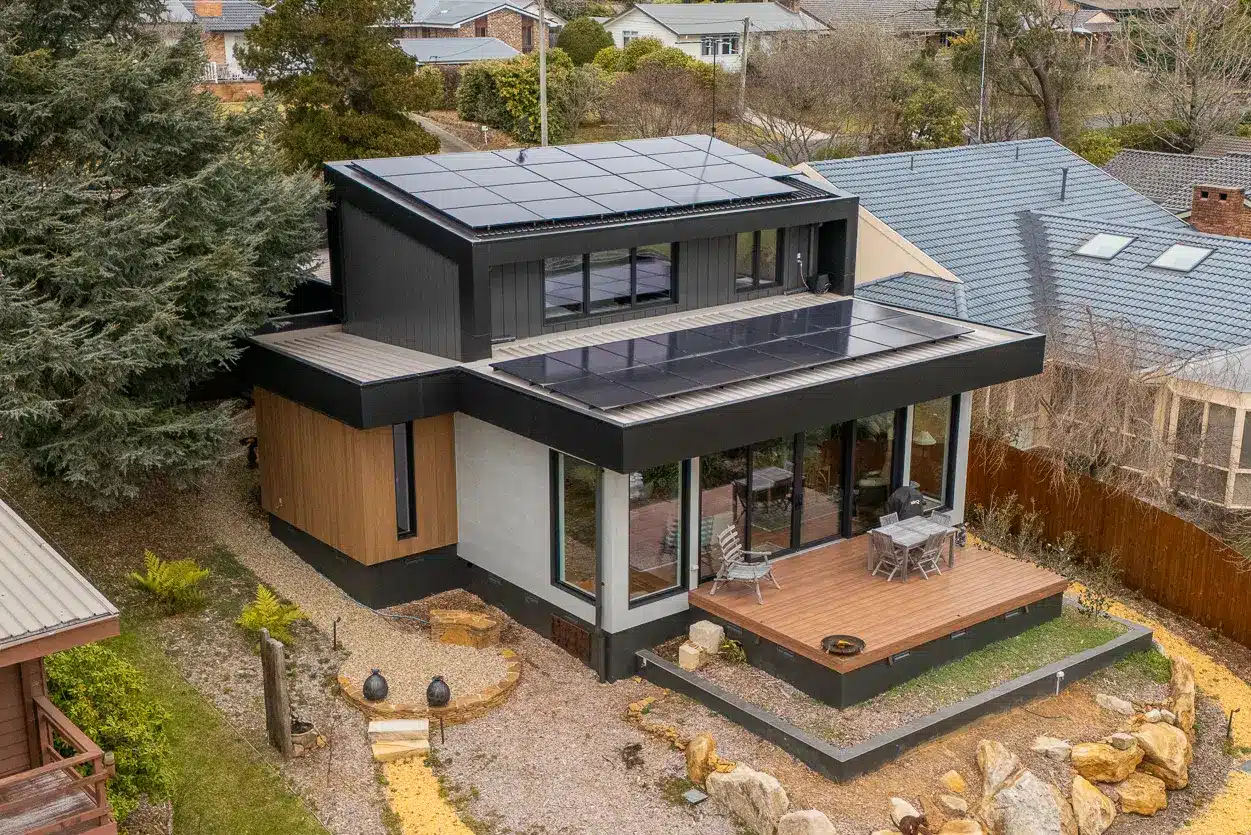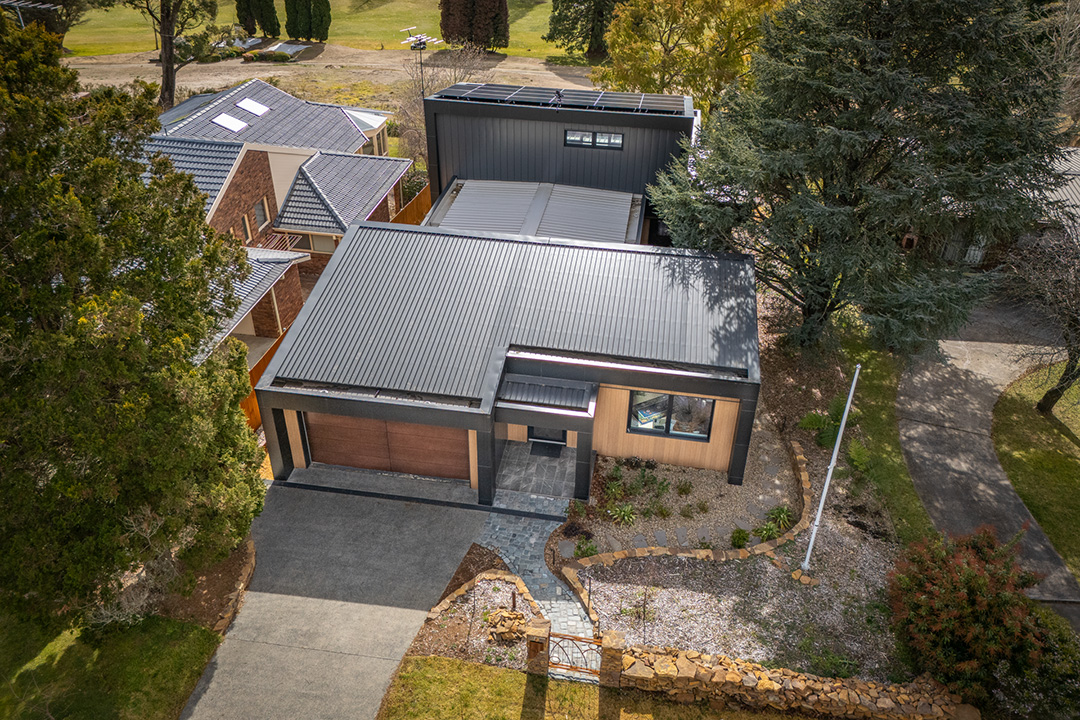
Embraced by the expanse of the Atlas Cedar tree canopy, the angular contours of the Gallery House emerge from the alpine landscape of New South Wales’ Blackheath in a sympathetic palette of unobtrusive neutrals. Nestled on a gentle slope adjacent to the Blackheath Golf Course, the home is defined by a neat, efficient and deliberate design language that relates to its locale with amicable sensitivity. But its deceptively simple form reveals a surprisingly intricate design ethos and an unexpectedly powerful core – far from a conventional dwelling, the Gallery House is a self-sufficient sanctuary designed for resilience, comfort and a profound connection to its natural surroundings under the banner of Passivhaus principles.
Developed by Villar Architects and the award-winning certified Green Builder, Blue Eco Homes, in close collaboration with the client, this dwelling began with a straightforward goal: to create a low-maintenance home that would offer long-term comfort and independence. But this initial ambition evolved into a much more rigorous pursuit of full Passivhaus certification and complete off-grid functionality – a goal that aligned perfectly with Blue Eco Homes’ core values. “We choose to build sustainably because it gives us immense satisfaction to know we’ve created a home our client loves with the lowest possible impact on the environment,” Joe Mercieca, Managing Director at Blue Eco Homes explains.
This philosophy underpinned every facet of the project, manifesting well before the dwelling was complete – during the construction process, an impressive 96.39% of waste was recycled or reused, resulting in an estimated 46.29 tCO2-e reduction in carbon emissions. These early achievements signalled a profound environmental commitment that would inform every material and design choice, including the dwelling’s robust technological engine.
Anatomy of a Passive powerhouse
The home’s autonomy is powered by a robust 12.28 kW solar array paired with a substantial 57.4 kWh battery bank, a combination ensuring a reliable energy supply through the region’s cold and often overcast winters. This technical prowess is matched by unparalleled physical integrity – the pursuit of Passivhaus certification demanded extreme airtightness, a goal not just met but exceeded with a verified blower door result of just 0.52 air changes per hour.
Joe explains that this remarkable performance was made possible thanks to Blue Eco Homes’ custom prefabricated building system, FAB-FYV, which, in combination with triple-glazed uPVC windows, enabled them to create a high-performance thermal envelope with outstanding precision.
The project’s commitment to resilience is evident in a multifaceted approach to fire safety. Built from low-carbon concrete and permanent polymer formwork walls, the dwelling’s substructure provides a fire-resistant foundation, which – in combination with the BAL-40 compliance of the windows – contributed to the building’s impressive, voluntarily-achieved BAL-29 rating, preparing the home for the harsh realities of its bushland context.
Inside, this focus on creating a resilient and healthy ecosystem continues. A palette of low-VOC finishes and paints, along with responsibly sourced flooring, ensures superior indoor air quality, with CO₂ levels averaging at a healthy 550 ppm. Similarly, the home’s thermal integrity and comfort have been considered in great depth – the indoor climate remains in the comfortable 18–24°C range throughout the year, with no active heating required.
DecoDeck: Bridging comfort and context
With this site-sensitive design anchored by the desire to integrate with the surrounding landscape, the success of the build hinged on a seamless transition between the comfort of the indoor environment and the beauty of the outdoors, establishing the dwelling’s backyard as a bridge between both realms.
This vision required a decking material that could withstand the harsh alpine climate while echoing the natural, understated aesthetic of the home. This uncompromising vision led the project team to DecoDeck, an aluminium system that combines a photo-realistic timber look with exceptional performance and durability.
“DecoDeck was selected for its unique alignment with Passivhaus and sustainable building requirements,” Joe notes. “It’s low-maintenance durability eliminates the need for staining or chemical treatments, and its UV, moisture and pest resistance are ideal for harsh mountain climates with extreme seasonal variations. Plus, being 100% recyclable aluminium supports circular material principles.”
DecoDeck is manufactured using lower-carbon aluminium, which reduces embodied carbon by up to 50%, while the DecoWood powder coat boasts a low-VOC profile mirroring the indoor finishes. Plus, the material is renowned for exceptional thermal conductivity, which enables it to dissipate heat rapidly, helping to maintain underfoot comfort even on hotter days and reducing localised area heating.
DecoDeck’s non-combustible nature and BAL-FZ rating also contributes to the home’s proactive BAL-29 compliance, while its resilient, timber-like aesthetic aligns with the client’s desire for a natural feel without environmental or functional trade-offs. “These characteristics supported both the performance and sustainability vision of the project, making DecoDeck a natural fit for the deck and outdoor transition areas,” Joe Mercieca explains.
Used for exposed high-traffic outdoor deck spaces, including areas over the concealed dual 10,000-litre rainwater tanks, the corrosion-resistant decking system became an essential facilitator of the vital dialogue between the structure and its surroundings – a process streamlined by the product’s efficient profile. “Its ease of installation and integrated fixing system also helped simplify construction in areas with limited access due to the protected Atlas Cedar and neighbouring boundaries,” Joe describes. “Importantly, DecoDeck’s low-maintenance nature supports the client’s desire for long-term independence and minimal upkeep.”
For the team at DECO, the project represents a powerful case study in holistic design. “The team at Blue Eco Homes are sustainable design trailblazers,” Simon Pearson, Architectural Business Manager at DECO enthuses. “To see DecoDeck integrated into a project of this calibre, where every single element is considered for its impact and performance, is incredibly rewarding. The Gallery House is an inspiring embodiment of how high-performance materials can help achieve exceptional environmental outcomes without compromising on sophisticated and site-responsive design, and we’re thrilled to have been able to contribute to this achievement.”
Passivhaus design as an act of care
The powerful convergence of Passivhaus principles that Blue Eco Homes masterfully incorporated into this dwelling is palpable, and its most compelling expression is the home’s ability to effortlessly translate the intricacy of highly technical systems into a tangible sense of security, autonomy and comfort. This seemingly “passive” dwelling emerges as an active facilitator of the life envisioned by its occupant, John who refers to his home as “a house that looks after you.”
How do you build such a caring house? The team at Blue Eco Homes has some lessons to share. “Material choices matter,” Joe Mercieca states. “Selecting low-maintenance, non-combustible and recyclable products like DecoDeck can significantly reduce lifecycle impact and enhance durability without compromising design. Similarly, this project demonstrates that prefab and Passivhaus can be complementary, rather than conflicting, and that data-driven off-grid solutions are viable in cold, variable climates.”
Diego Villar from Villar Architects adds that the Gallery House also highlights the immense potential of design that thoughtfully responds to place. “Embracing natural features, like trees and slopes, can yield both aesthetic and thermal benefits,” Diego explains. But, perhaps most importantly, underlying these lessons is a crucial shift in the perception of clients as essential collaborators. “Their vision and values can elevate a sustainable home from good to exceptional,” Diego says proudly, pointing to the Gallery House as an embodiment of that transformative power.
This life-affirming dwelling gently settles into its alpine locale in a quiet, self-aware affirmation that exceptional performance and a symbiotic connection with nature are not mutually exclusive. In fact, this sensitive synthesis of home and context yields a resilient, site-responsive structure thoughtfully designed to care for both its occupant and surroundings for decades to come.


